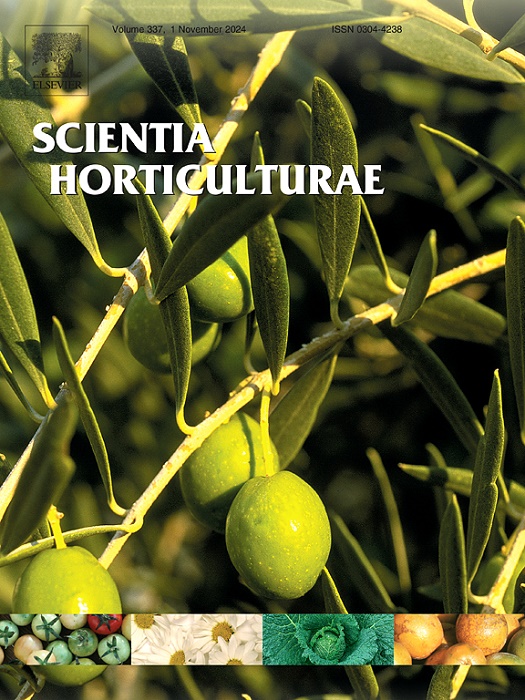Effects of foliar applications of methyl jasmonate alone or with urea on anthocyanins content during grape ripening
IF 3.9
2区 农林科学
Q1 HORTICULTURE
引用次数: 0
Abstract
Anthocyanins, the main phenolic compounds responsible for the color of red grapes and wines, exhibit antioxidant and antimicrobial properties and offer various health benefits for humans. Currently, climate change can affect grape quality by causing a decoupling between the technological and phenolic maturities of the grapes. Foliar application of methyl jasmonate (MeJ) and urea (Ur) can be a tool to mitigate the global warming effects in the vineyard. The aim of this work was to study i) the development of anthocyanin content in ‘Tempranillo’ grapes along the ripening process, and ii) the effect of foliar application of MeJ and MeJ+Ur on these phenolic compounds over two vintages (2019 and 2020). Overall, in the first vintage, anthocyanins peaked in their concentrations in the pre-harvest or harvest moments; whereas in the second vintage, the highest contents of these phenolic compounds were reached at harvest time, after that, a maintenance or decreased of their concentrations was observed. In both vintages, non-acylated anthocyanins was the most abundant family of anthocyanins. Foliar application of MeJ+Ur was more effective in enhancing anthocyanin biosynthesis than MeJ treatment, which also increased anthocyanin content compared to control grapes. Therefore, MeJ and Ur foliar treatment could present a synergy in anthocyanin biosynthesis by the plant. Moreover, the impact of these applications varied across vintages, and also the content of anthocyanins in grapes, probably due to different climatological conditions. Consequently, the two foliar treatments, MeJ and MeJ+Ur, could be a suitable tool to increase anthocyanins biosynthesis in grapes, and thus improve grape quality.单独叶面喷施茉莉酸甲酯或与尿素一起叶面喷施对葡萄成熟期花青素含量的影响
花青素是造成红葡萄和葡萄酒颜色的主要酚类化合物,具有抗氧化和抗菌特性,对人体健康有多种益处。目前,气候变化会导致葡萄的技术成熟期和酚类成熟期脱钩,从而影响葡萄的质量。叶面喷施茉莉酸甲酯(MeJ)和尿素(Ur)可以缓解葡萄园的全球变暖效应。这项工作的目的是研究 i) "添普兰尼洛 "葡萄花青素含量在成熟过程中的变化,以及 ii) 在两个年份(2019 年和 2020 年)叶面喷施 MeJ 和 MeJ+Ur 对这些酚类化合物的影响。总体而言,在第一个年份中,花青素的浓度在采收前或采收期达到峰值;而在第二个年份中,这些酚类化合物的含量在采收期达到最高,之后浓度保持不变或有所下降。在这两个年份中,非酰化花青素是含量最高的花青素家族。与 MeJ 处理相比,叶面喷施 MeJ+Ur 能更有效地促进花青素的生物合成,同时也能提高花青素含量。因此,MeJ 和 Ur 的叶面处理对植物花青素的生物合成具有协同作用。此外,可能由于气候条件不同,这些应用对不同年份葡萄的影响以及葡萄中花青素的含量也不尽相同。因此,MeJ 和 MeJ+Ur 这两种叶面处理方法可能是增加葡萄花青素生物合成从而提高葡萄品质的合适工具。
本文章由计算机程序翻译,如有差异,请以英文原文为准。
求助全文
约1分钟内获得全文
求助全文
来源期刊

Scientia Horticulturae
农林科学-园艺
CiteScore
8.60
自引率
4.70%
发文量
796
审稿时长
47 days
期刊介绍:
Scientia Horticulturae is an international journal publishing research related to horticultural crops. Articles in the journal deal with open or protected production of vegetables, fruits, edible fungi and ornamentals under temperate, subtropical and tropical conditions. Papers in related areas (biochemistry, micropropagation, soil science, plant breeding, plant physiology, phytopathology, etc.) are considered, if they contain information of direct significance to horticulture. Papers on the technical aspects of horticulture (engineering, crop processing, storage, transport etc.) are accepted for publication only if they relate directly to the living product. In the case of plantation crops, those yielding a product that may be used fresh (e.g. tropical vegetables, citrus, bananas, and other fruits) will be considered, while those papers describing the processing of the product (e.g. rubber, tobacco, and quinine) will not. The scope of the journal includes all horticultural crops but does not include speciality crops such as, medicinal crops or forestry crops, such as bamboo. Basic molecular studies without any direct application in horticulture will not be considered for this journal.
 求助内容:
求助内容: 应助结果提醒方式:
应助结果提醒方式:


